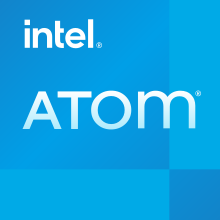
Back انتل اتوم Arabic Intel Atom Catalan Intel Atom Czech Intel Atom German Intel Atom Spanish Intel Atom Estonian اینتل اتم Persian Intel Atom Finnish Intel Atom French Intel Atom HE
This article needs to be updated. (August 2021) |
 Logo since 2020 | |
| General information | |
|---|---|
| Launched | 2008–2009 (as Centrino Atom) 2008–present (as Atom) |
| Marketed by | Intel |
| Designed by | Intel |
| Common manufacturer(s) |
|
| Performance | |
| Max. CPU clock rate | 600 MHz to 4.0 GHz |
| FSB speeds | 400 MT/s to 667 MT/s |
| Architecture and classification | |
| Technology node | 45 nm to Intel 7 |
| Instruction set | IA-32, x86-64 (not for the N2xx and Z5xx series) |
| Extensions | |
| Physical specifications | |
| Cores |
|
| GPU(s) | Intel Graphics Technology (some) |
| Package(s) |
|
| Products, models, variants | |
| Core name(s) | |
| History | |
| Predecessor(s) | Stealey |
Intel Atom is a line of IA-32 and x86-64 instruction set ultra-low-voltage processors by Intel Corporation designed to reduce electric consumption and power dissipation in comparison with ordinary processors of the Intel Core series. Atom is mainly used in netbooks, nettops, embedded applications ranging from health care to advanced robotics, mobile Internet devices (MIDs) and phones. The line was originally designed in 45 nm complementary metal–oxide–semiconductor (CMOS) technology and subsequent models, codenamed Cedar, used a 32 nm process.[2]
The first generation of Atom processors are based on the Bonnell microarchitecture.[3][4] On December 21, 2009, Intel announced the Pine Trail platform, including new Atom processor code-named Pineview (Atom N450), with total kit power consumption down 20%.[5] On December 28, 2011, Intel updated the Atom line with the Cedar processors.[2]
In December 2012, Intel launched the 64-bit Centerton family of Atom CPUs, designed specifically for use in servers.[6] Centerton adds features previously unavailable in Atom processors, such as Intel VT virtualization technology and support for ECC memory.[7] On September 4, 2013, Intel launched a 22 nm successor to Centerton, codenamed Avoton.[8]
- ^ "Product Fact Sheet: Accelerating 5G Network Infrastructure, from the Core to the Edge". Intel Newsroom (Press release). Retrieved April 12, 2020.
L1 cache of 32KB/core, L2 cache of 4.5MB per 4-core cluster and shared LLC cache up to 15MB.
- ^ a b Anand Lal Shimpi. "Intel's Atom N2600, N2800 & D2700: Cedar Trail, The Heart of the 2012 Netbook". Archived from the original on April 29, 2014. Retrieved December 28, 2011.
- ^ Jeff Moriarty (1 April 2008). "'Atom 101' - Deciphering the Intel codewords around MIDs". Archived from the original on 29 February 2012. Retrieved 4 August 2010.
- ^ Anand Lal Shimpi (January 27, 2010). "Why Pine Trail Isn't Much Faster Than the First Atom". Archived from the original on January 4, 2014. Retrieved August 4, 2010.
- ^ "Intel Announces Next-Generation Atom Platform". Intel. Archived from the original on June 6, 2013.
- ^ "Products (Formerly Centerton)". Archived from the original on October 14, 2013. Retrieved March 22, 2013.
- ^ Ryan Smith (December 11, 2012). "Intel Launches Centerton Atom S1200 Family, First Atom for Servers". Archived from the original on May 2, 2014. Retrieved March 22, 2013.
- ^ Inside Intel's Atom C2000-series 'Avoton' processors Archived February 9, 2014, at the Wayback Machine